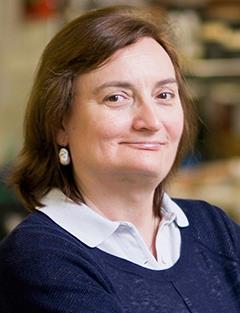-
About
- Departments & Offices
-
Academics
- Physician Assistant
- Special Master’s (MBS)
-
Admissions & Financial Aid
- Tuition & Fees
-
Student Life
-
- Student Resources by Program
- Academic & Student Support
- Wellness & Wellbeing
- Student Experience
- Events & Traditions
-
-
Research
- Research Labs & Centers
-
Local & Global Engagement
- Global Health Programs
- Community Engagement

Giuseppina Tesco
(617) 636-4050
136 Harrison Avenue

Research/Areas of Interest
Alzheimer's disease (AD) is a devastating neurodegenerative disorder that results in loss of memory and cognitive function, eventually leading to dementia. A key neuropathological event in AD is the cerebral accumulation of senile plaques formed by aggregates of amyloid-beta-peptides derived from serial proteolysis of the amyloid precursor protein by BACE1 and gamma-secretase. Our studies have revealed a novel mechanism of BACE1 regulation mediated by the clathrin adaptor Golgi-localized gamma-ear-containing ARF binding protein 3 (GGA3) GGA3. We have demonstrated that BACE1 is normally degraded in the lysosomes. and found that GGA3 and BACE1 ubiquitination play a key role in trafficking BACE1 to the lysosomes. More recently, we have begun to unravel the function of GGA3 in neurons. We have recently discovered that that GGA3 is essential for BACE1 axonal trafficking. Our findings demonstrate that GGA3 loss of function triggers BACE1 axonal buildup and initiates a cascade of events leading to the axonal damage characteristic of the early stage of AD in the absence of extracellular Abeta deposition in mice. More importantly, we identified a GGA3 rare variant, Ins545T co-segregated with late-onset AD (LOAD) in patients with African ancestry. Ins545T results in a loss of function. Our studies may contribute to a better understanding of AD genetic risk factors in the African American population, which are currently understudied. More recently, we developed a bioengineered model from patient-derived AD iPSCs, which develops time-dependent AD-related phenotypes and establishes a temporal correlation among them. Furthermore, AD iPSC-derived cultures recapitulate transcriptomic features of AD patients. Our 3D bioengineered neural tissue model advances neurodegenerative disease research by providing a platform for long-term culture with accurate replication of age-related pathologies. It enables detailed study of disease mechanisms, facilitates high-throughput drug screening, and supports personalized medicine using patient-derived iPSCs. By bridging the gap between preclinical and clinical research, our model has the potential to accelerate the discovery and development of effective therapies for AD and other neurodegenerative disorders.
Education
- Doctor of Philosophy, University of Florence, Florence, Italy, 1999
- Doctor of Medicine, University of Florence, Florence, Italy, 1989